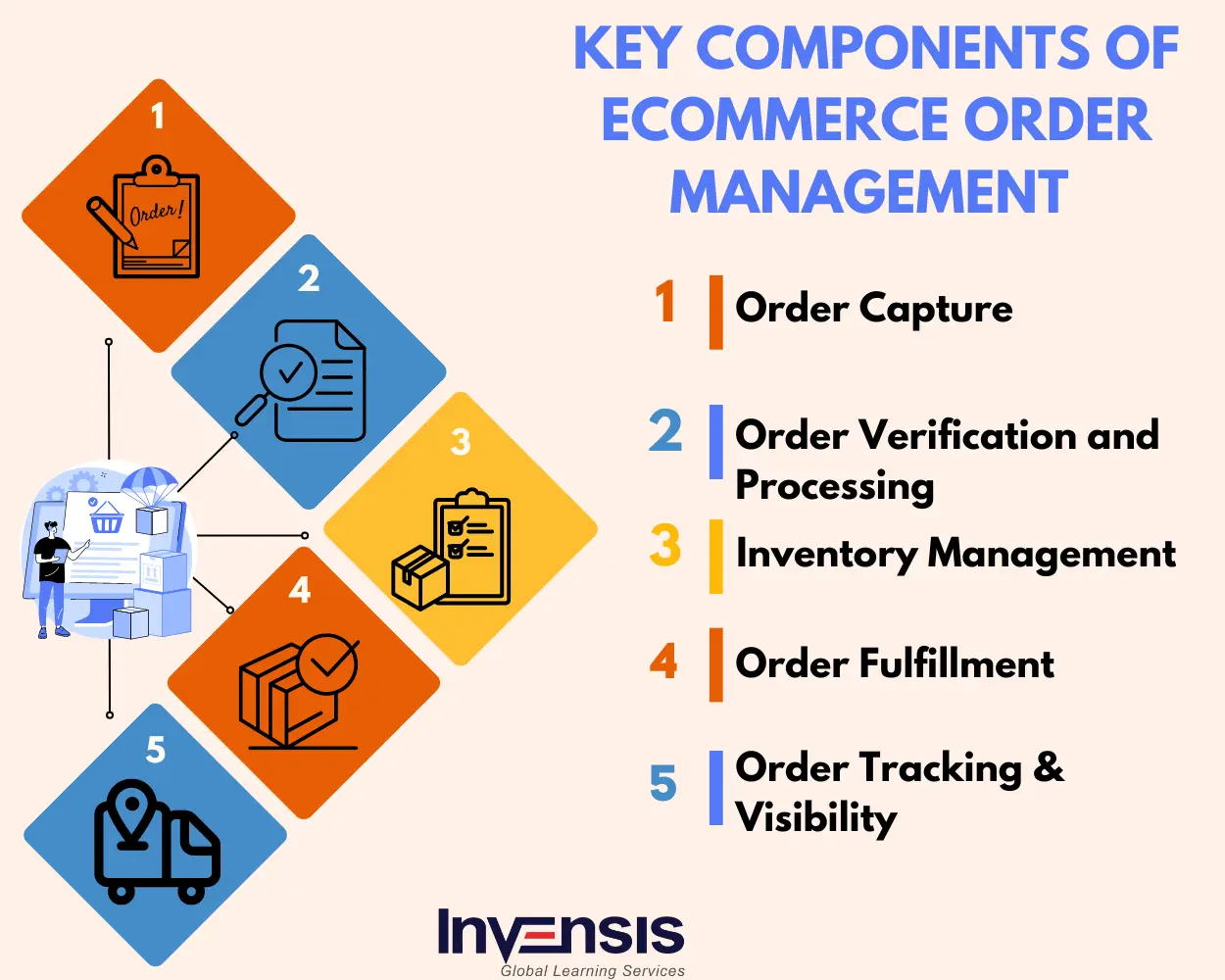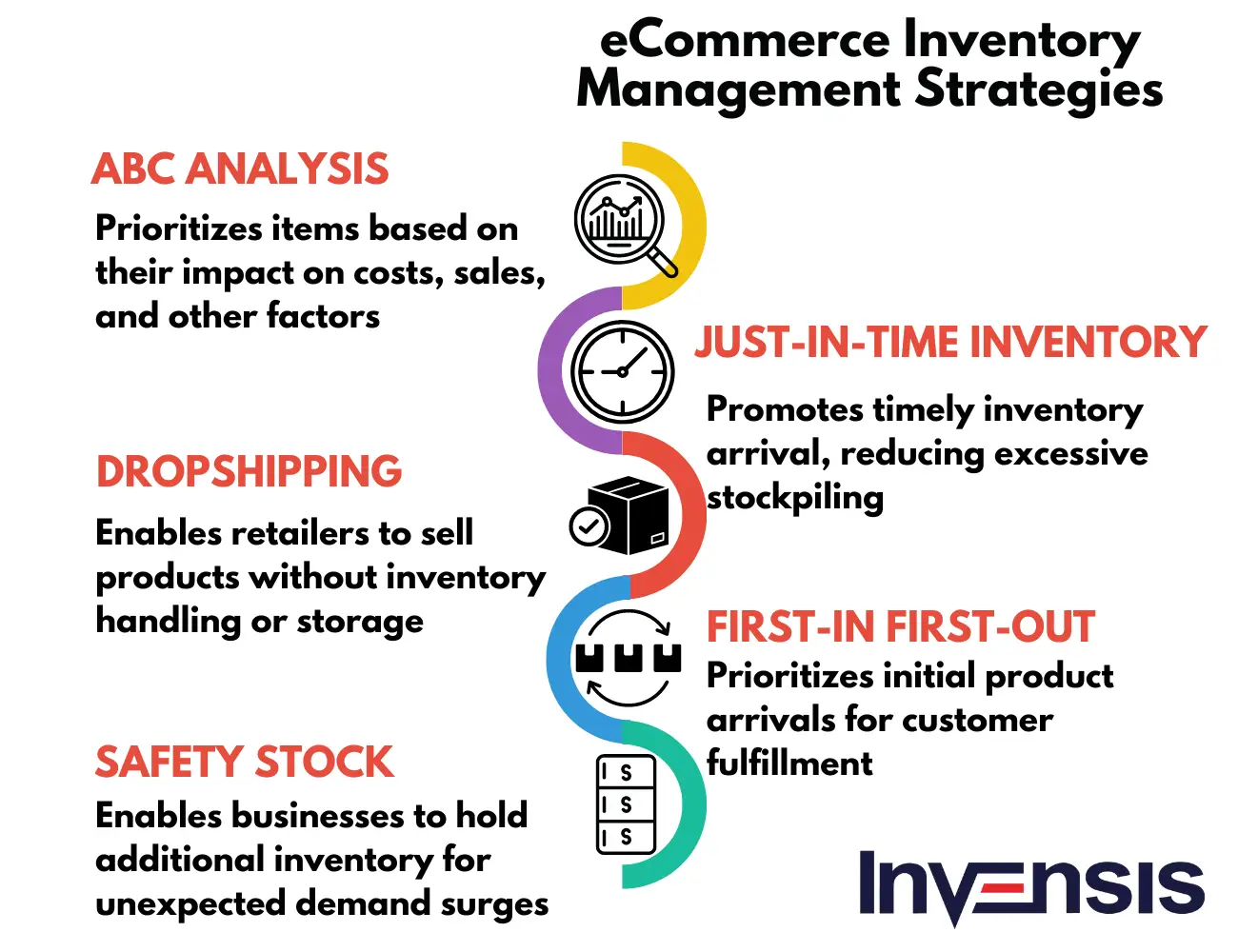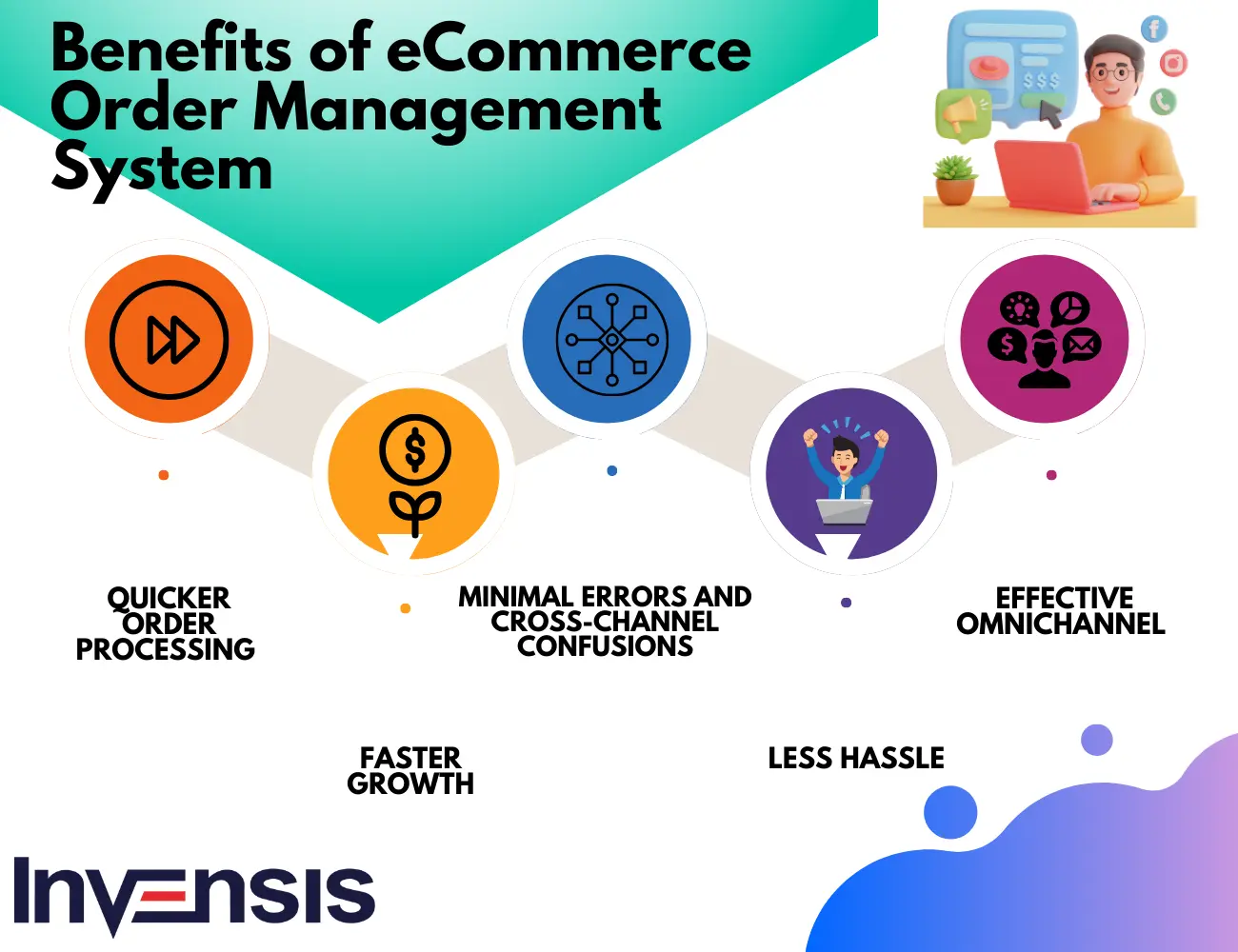.webp)
 Order Management
Order ManagementeCommerce Order Management Process: Improving Fulfillment Efficiency in 2025

Content
The success of an e-commerce business rests on how well it manages and fulfills orders. An eCommerce order process tracks an order from the initial placement until the order gets delivered to the customer and all other stages. It ensures efficient order processing leading to faster delivery and increased customer satisfaction.
A well-defined process for fulfilling e-commerce orders is crucial for several reasons. While at the front end, it ensures consistency and accuracy in order processing, minimizing errors and reducing the likelihood of customer dissatisfaction, at the back end, it enables efficient inventory management, allowing businesses to optimize stock levels and avoid stockouts or overstocking.
Thus, by building a robust eCommerce order process, e-commerce businesses can reduce friction in the order management process, create a structured framework to ensure seamless order flow end-to-end and enhance user satisfaction.
This blog will delve into the key aspects of eCommerce order management processes and explain how they can ensure enhanced business outcomes.
Understanding eCommerce Order Process
To better understand the eCommerce order management process, let's consider the product delivery lifecycle end-to-end. When a customer places an order, the order management system (OMS) captures the details and automatically verifies inventory availability. It then initiates the fulfillment process, including picking, packing, and shipping.
The OMS automates inventory levels in real-time, and generates shipping labels. With the help of these labels it is possible to track the shipment during its journey and provide customer order status updates. This automation minimizes errors, reduces processing time, and ensures timely order fulfillment.

eCommerce Order Management Process: Key Activities
Ecommerce order management processes encompass the following activities for fulfilling customer order efficiently:
1. Order Placement
Order placement in eCommerce refers to the process where customers browse through available products or services on an online platform, select the desired items, and proceed to complete the purchase.
Order placement plays a crucial role in the eCommerce order management process. It is the pivotal step where customers make purchasing decisions, directly impacting revenue generation. Smooth and efficient order placement ensures a positive customer experience, leading to customer satisfaction, repeat business, and brand loyalty.
Accurate order placement data is vital for inventory management, demand forecasting, and efficient order processing. Proper order placement enables businesses to track and manage orders effectively, reducing errors, minimizing delays, and optimizing resource allocation.
eCommerce companies need to simplify the order placement process to enhance user experience. They must focus on a user-friendly interface with clear navigation and a prominent "Order Now" button. Besides, they must optimize the ordering system for mobile devices and provide visual representations, including high-quality images and detailed descriptions.
2. Inventory Management
Inventory management is the process of monitoring, tracking, and controlling the inventory of products or goods. It includes stock replenishment, inventory tracking, order fulfillment, and minimizing stock outs or overstock situations.
Inventory management plays a crucial role in the ecommerce order management process. Effective inventory management ensures that the right products are available at the right time, minimizing stockouts and overstock situations.
Inventory management also helps in accurate order fulfillment, preventing delayed shipments and customer dissatisfaction. By maintaining optimal inventory levels, ecommerce businesses can streamline their supply chain, reduce storage costs, and improve cash flow.
A real-time inventory tracking and management system helps ensure accurate product availability. By integrating inventory systems with order management system, orders can be automatically routed to the appropriate warehouses or fulfillment centers, expediting the process and reducing errors.
3. Order Processing
Order processing in eCommerce refers to a series of activities, such as verifying and validating orders, authorizing payment, preparing items for shipment, and generating invoices.
Order processing holds significant importance in the ecommerce order management process. It serves as the operational backbone that ensures the smooth and efficient execution of customer orders. By accurately processing orders, businesses can provide timely fulfillment of orders, reducing the risk of delayed shipments and customer dissatisfaction.
Order processing also contributes to enhanced inventory management, allowing businesses to maintain optimal stock levels, reduce costs, and make data-driven decisions.
To streamline order processing, businesses need to integrate an automated order management system that seamlessly connects with inventory, payment, and shipping systems, helps eliminate manual data entry, and reduces processing time.
Businesses should also implement real-time order tracking capabilities that allow customers to monitor the progress of their orders, enhancing transparency and reducing customer inquiries.

4. Fulfillment & Shipping
Fulfillment & shipping refers to the process of preparing and delivering customer orders. It includes picking the ordered items from inventory, securely packaging them, generating shipping labels, and coordinating with shipping carriers or logistics partners for timely delivery.
Fulfillment and shipping play a vital role in the ecommerce order management process. Timely and accurate fulfillment ensures that customer orders are prepared efficiently and shipped on time thereby minimizing delays and enhancing customer satisfaction.
Streamlined shipping operations, including reliable carrier partnerships along with real-time tracking, provide customers with visibility into their shipments, instilling trust and reducing anxiety.
Businesses need to employ various strategies to streamline fulfillment and shipping processes. They should implement an efficient order management system that integrates with inventory and shipping systems to help automate and streamline the fulfillment process.
Businesses should also offer multiple shipping options and clear communication on estimated delivery times to ensure flexibility and transparency to customers. Additionally, utilizing advanced shipping technology, such as real-time package tracking and delivery notifications, will also help customers stay informed about their shipments.
5. Customer Communication
Customer communication is the process of effectively communicating with customers at various stages of the order fulfillment process. It involves providing timely updates on order confirmations, shipment notifications, delivery tracking details, and any potential delays or issues that may arise.
Clear and effective communication ensures a seamless and satisfactory customer experience from purchase to delivery. It keeps customers informed about their order status, shipment updates, and any potential delays, instilling confidence and trust in the services. Also, timely and proactive communication helps manage customer expectations, reducing inquiries and complaints.
To streamline customer communication, businesses should implement automated order confirmation emails and notifications. It will provide clear and concise information on the order status, shipping details, and estimated delivery dates, thus keeping customers informed at every stage.
Offering self-service options such as online order tracking portals will also empower customers to easily check the progress of their orders without the need for direct communication. Additionally, providing dedicated customer support channels like live chat or email support enables prompt responses to customer inquiries and concerns.

6. Return & Exchanges
Returns and exchanges in ecommerce refer to the process by which customers can return or exchange products they have purchased online. It allows customers to request a refund or exchange for reasons such as product defects, incorrect sizing, or changing preferences.
Returns and exchanges play a crucial role in customer satisfaction and retention. By offering hassle-free return and exchange options, businesses instill confidence in customers, reassuring them that their purchase is risk-free. A streamlined return and exchange process also demonstrates the commitment of businesses to customer-centricity.
Streamlining the return and exchange process in ecommerce can greatly enhance the customer experience for businesses. Firstly, implementing a clear and user-friendly return policy that includes eligibility criteria, time frames, and instructions simplifies the return process for customers.
Secondly, offering self-service options, such as online return request forms, enables customers to initiate returns conveniently. Also, providing pre-paid return labels eliminates the hassle of arranging return shipping.
7. Customer Support
Customer support in eCommerce is the provision of assistance and guidance to customers throughout their shopping journey. It includes addressing customer inquiries, concerns, and issues related to products, orders, payments, and delivery. Customer support channels in ecommerce include live chat, email, phone support, or self-service help centers.
Customer support serves as a vital link between customers and the business, providing assistance and resolving issues throughout the entire purchase journey. Effective customer support ensures that customer inquiries, concerns, and problems are addressed promptly and satisfactorily.
Businesses must provide customers with multiple support channels along with convenient options to help customers seek assistance anytime and anywhere they want. Businesses should also implement a comprehensive knowledge base or self-service portal, allowing customers to find answers to common questions independently.
Utilizing chatbots or AI-powered virtual assistants can also help businesses automate and provide instant response to customer inquiries. Driving the entire process with efficient ticket management systems will ensure the timely resolution of customer issues and prevent any queries from slipping through the cracks.
Key Benefits of Efficient eCommerce Order Fulfillment
Proper eCommerce order fulfillment is a critical component of a successful online business. It directly impacts customer satisfaction, operational efficiency, and overall business growth. Here are the key benefits:
- Improved Customer Satisfaction: Efficient order fulfillment ensures timely deliveries, reducing errors and increasing reliability. This enhances customer trust and loyalty, fostering repeat business. Customers are more likely to return if they receive products on time and in good condition.
- Reduced Operational Costs: Proper fulfillment streamlines processes, cutting down on unnecessary overheads. With optimized workflows and fewer returns or errors, businesses save on labor, shipping, and inventory management costs, improving their overall profitability.
- Increased Efficiency: Automating and optimizing fulfillment processes leads to quicker and more accurate order processing. This allows businesses to handle a higher volume of orders, minimizing delays and maximizing output while reducing the risk of human errors.
- Scalability: Efficient order fulfillment systems are scalable, allowing businesses to grow without facing significant challenges. As the demand increases, businesses can easily adjust resources, expand warehousing, and implement new technologies without disrupting the workflow.
- Enhanced Brand Reputation: Customers associate fast and accurate order fulfillment with professionalism. A well-managed fulfillment process builds a positive brand image, which helps attract new customers and retain existing ones, leading to greater market trust and recognition.
- Better Inventory Management: Accurate order fulfillment relies on up-to-date inventory data. Proper management reduces stockouts and overstocking issues, ensuring businesses can meet customer demand while maintaining optimal stock levels, preventing unnecessary storage costs or lost sales.
- Global Reach: A streamlined fulfillment process enables businesses to expand their reach internationally by efficiently managing cross-border shipping and customs. This reduces barriers for international customers and opens up new markets, fostering growth and expanding the customer base.
- Data Insights for Improvement: By tracking orders, shipping, and customer feedback, businesses gain valuable insights into their operations. These data points help identify areas for improvement, from shipping speed to packaging quality, optimizing the entire fulfillment cycle for better performance.
Conclusion
The future of eCommerce order processing holds exciting possibilities given that in the days ahead it will be taken over by emerging technologies such as AI, ML, Blockchain technology, and others. Much of the order management process will be automated, resulting in higher order accuracy and quicker processing time with the power of AI and machine learning. Technologies like Robotic Process Automation (RPA) and IoT devices will streamline operations and will enable faster order fulfillment and real-time inventory visibility. Together, these advancements will enable eCommerce businesses to provide faster, more accurate, order fulfillment.
At Invensis, we help businesses across the globe initiate consistent growth through the use of our tailored and tech-agnostic eCommerce order processing services. We have wide experience transforming how ecommerce businesses handle orders, ensuring seamless operations and superior customer satisfaction. It includes harnessing the power of real-time inventory tracking, intelligent order routing, and automated fulfillment processes to streamline your workflow.
With our expert guidance, you can take your eCommerce business to the next level and realize exceptional revenue growth and better customer satisfaction. Contact us now to improve your eCommerce order management process and boost your online sales rapidly.
Discover Our Full Range of Services
Click HereExplore the Industries We Serve
Click HereBlog Category
Related Articles

Find the leading accounting firms in Singapore trusted by businesses for audit, tax, and advisory services.
November 6, 2025
|

Explore the leading accounting firms in South Africa providing expert audit, tax, cloud accounting, and payroll services. Learn about their key features and unique offerings.
November 6, 2025
|

Explore what project accounting is, how it works, and why it’s essential for businesses. Understand key principles, revenue recognition methods, and best practices to improve your knowledge.
October 7, 2025
|
Services We Provide
Industries We Serve





.webp)